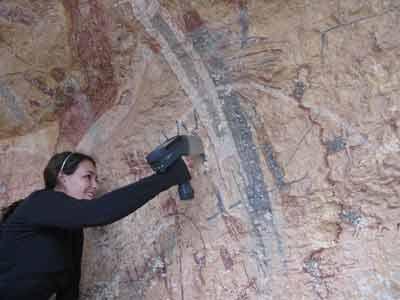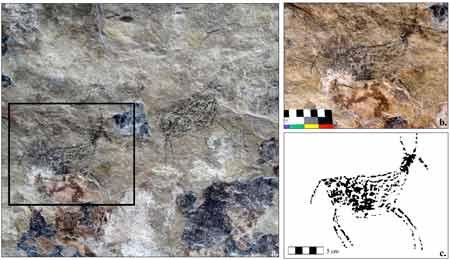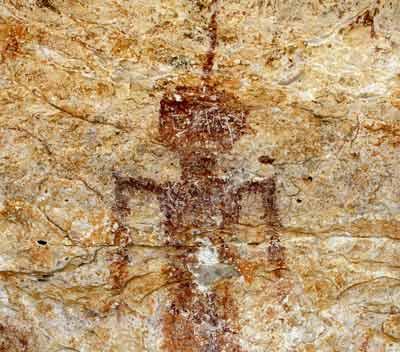Blake de Pastino
Source -http://westerndigs.org/ancient-rock-art-in-texas-yields-surprising-new-finds/
New technology is providing unexpected insights into some of the most distinctive rock art in the American West, archaeologists say.
The canyonlands of Texas’ Lower Pecos River are home to thousands of grand, colorful pictographs — depictions of people, animals, spirits, and often inscrutable symbols — painted in caves as much as 4,000 years ago.

A researcher uses a portable x-ray fluorescence scanner to analyze the pigments of a Lower Pecos pictograph panel. (Courtesy Karen Steelman)
But recent research is yielding new impressions of the ancient glyphs, revealing for example that prehistoric artists who painted in different styles used different ingredients for their pigments.
What’s more, new dating techniques suggest that a signature style of Lower Pecos rock art may have persisted thousands of years longer than had been thought.
Dr. Karen Steelman, a specialist in archaeological chemistry at the University of Central Arkansas, came upon these findings with her colleagues while studying the pictographs of Seminole Canyon State Park in southwest Texas.
Although many of the park’s images had been analyzed before, Steelman’s team brought a new technology to the task: portable X-ray fluorescence (pXRF).
Using a handheld pXRF device, which looks something like a state trooper’s radar gun, the archaeologists were able to scan rock paintings on site and get immediate readings on the chemical makeup of the pigments used to make them.
With support from the archaeology nonprofit SHUMLA, the team used this technology on different styles and sizes of pictographs in order to compare results.
In Seminole Canyon’s Black Cave, for instance, the scientists analyzed giant tableaux painted in what’s thought to be the region’s earliest style, known simply as the Pecos River Style — featuring colorful, towering human-like figures sporting headdresses, holding staffs, and flanked by animals or shamanic symbols.
But the same cave also bears pictures made in a simpler, smaller-scale style known as Red Linear — portraying stick-like figures of people and animals in more quotidian scenes, like hunting parties or fertility rites.
The team’s scans of these pictographs showed that the black paint used to create the shamans and spirit-beasts of the Pecos River Style was made from the mineral manganese. But all of the black paint used in Red Linear scenes in the same cave, and another nearby site, turned out to have been rendered in charcoal.
“Two different styles are done in different pigments,” Steelman said in an interview. “This raises several questions: Do the two styles and use of different pigment represent different cultural groups? Or are they different functions of art within the same society?”
The discovery marks the first widespread use of charcoal in the Lower Pecos region, Steelman said, with about 20 human and animal figures in three different panels found in two separate caves having been made with charcoal-based paint.
While the reason for this difference in materials remains unexplained, “there does appear to be some type of trend” in how the pigments were used by prehistoric painters, Steelman said.

This image of a deer, made in the simple Red Linear style, was found to have been rendered in charcoal. Another black deer nearby, painted with manganese in the Pecos River style, was dated to 500 CE, thousands of years more recent than the style was thought to have been used;(Courtesy Karen Steelman)
Moreover, a sample of the manganese taken from one of Black Cave’s Pecos River panels returned some “surprising” results, she added.
As the earliest known style in the region, Pecos River painting is thought to have been the fashion among Texas Paleoindians about 4,000 years ago, but radiocarbon dating of one such pictograph — a painting of a deer — was dated to around the year 500 CE.
“The younger age for Pecos River style is surprising and very well could be proven wrong,” she said.
“But … it leads us to some interesting questions about the age of Pecos River style paintings, which are usually thought to be 3,000 to 4,000 years old.”

Iron-based minerals were used to paint most of the red pictographs, research showed, including this depiction of an unidentified human-like figure, which had the highest iron content of any of the pictures studied. (Courtesy Karen Steelman)
While the more recent date poses some questions, she said, the team’s discovery of charcoal in some of the rock art may help provide answers.
“It is much easier to radiocarbon-date charcoal paintings,” she explained. “Charcoal pigment dates are more reliable.”
So, future research might focus on dating some of the charcoal-based rock art, to help establish historical ranges for the different styles and pigments used throughout the Lower Pecos.
“As so often happens with research, we have created more questions than answers,” Steelman concluded.
“Did the Pecos River style endure for a longer time period than previously thought? Or is our radiocarbon date for the black deer an outlier?
“While the younger radiocarbon age is only one new measurement,” she said, “the result is intriguing.”
The researchers report their findings on the use of charcoal in Texas rock art in the journal Archaeometry, and their radiocarbon dating will appear in an upcoming issue of The Bulletin of the Texas Archeological Society.